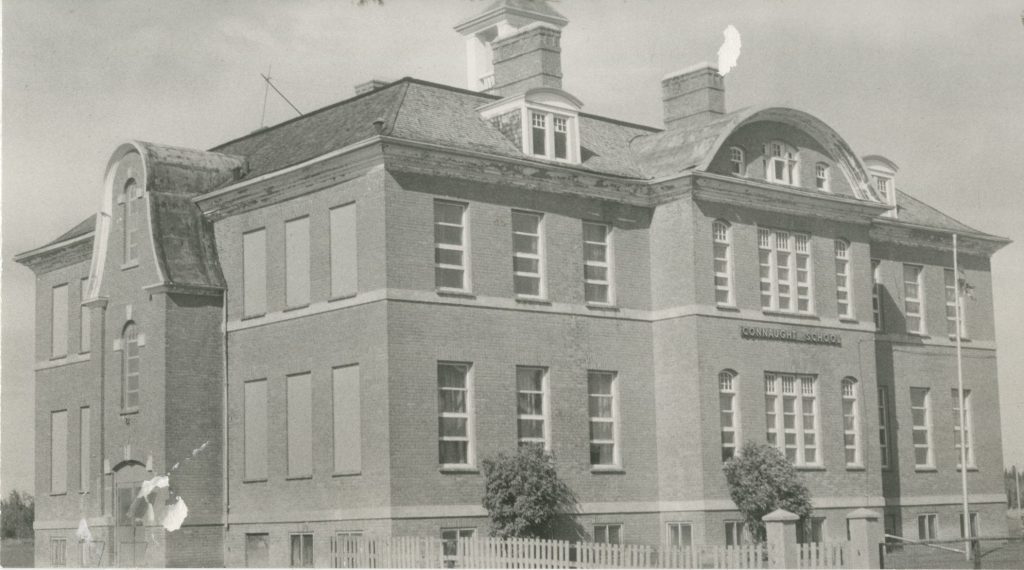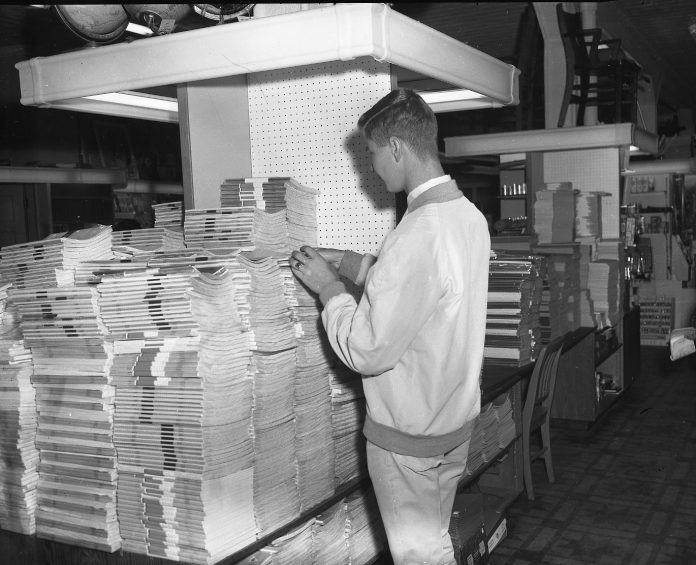Fred Payton
Prince Albert Historical Society
This week, for the first time since May 21, the big front doors of the Historical Museum are not open from 9:00 a.m. to 5:00 p.m. For members of the Prince Albert Historical Society, this signifies the end of the summer season and the start of the winter season.
The change in seasons does not mean that the Historical Museum is closed. It simply means that access is different. Anyone wanting to visit the Museum, or the Bill Smiley Archives, will need to access the building through the east door, and during reduced hours (from 9:00 a.m. to 4:00 p.m. Monday through Friday). Our other museums (Police and Corrections, Evolution of Education, and the John and Olive Diefenbaker Museum) still can be accessed, but only by making an appointment (call 306-764-2992).
The change in access results from the annual return to classes of our Summer Interpreters. I, for one, will miss their smiling faces, their willingness to provide assistance, and their insatiable quest for knowledge about the history of Prince Albert and area. Like the other staff and volunteers of the Society, I wish them well as they pursue their further education.

With the return to school which occurs each autumn, I often have feelings of nostalgia. It is quite some time since I headed off to university, and even longer since I went back to school locally, so it is probably getting ready for my children’s school days which I most remember. But little things, like lining up at Eagle’s Stationery or Adams Book Store to buy supplies which lingers in my mind. Not for us, or for my parents, were school supplies bought from big chain stores or through mail order firms such as Amazon.
Of course, I also think back on the history of education in the area. From the establishment of the Isbister settlement in what is now Prince Albert’s west end to the institutions of today, education has been important to its citizens. How it is provided is what is so very different.
In the early 1860s, James Isbister taught his children and those of his relatives in the kitchen or the sitting rooms of their rude log shacks. The First Nations’ leaders finally gave their consent for Nisbet to establish his mission here when he agreed to provide schooling for their children, schooling which took place in tents and later in the mission house. Bishop McLean received approval from the Dominion government to establish the first institution of higher learning (Emmanuel College) on the outskirts of present-day Prince Albert, and the Sisters of the Faithful Companions of Jesus established a convent school which opened on Sept. 3, 1883 with ten non-Catholic and one Roman Catholic student in its first senior class (high school) and twelve students in the elementary class.
Although education was deemed to be important, the provision of educational programming did not always run smoothly. The second bishop of the Anglican Diocese did accept the need for Emmanuel College which Bishop McLean felt, but with the support of the area First Nations leaders, he transformed the college into a school for First Nations students. This programme ran smoothly until 1907 when the Dominion government under Sir Wilfrid Laurier determined that it was not accomplishing his government’s goal of assimilation, and he refused to increase the necessary funding for the school’s operation.
The Sisters of the Faithful Companions of Jesus found that their enrolment dropped significantly when the Nisbet School opened in the late 1880s, so they relocated to Duck Lake to open a school there. The Nisbet School itself was short-lived, as it burnt to the ground on New Year’s Day 1890. There were insurance issues which precluded the school being replaced.
It was not only the people of Prince Albert who were interested in ensuring their children were educated. As early as March, 1877, the Council of the North-West Territories spent an entire day considering a “Petition of Moise Oullette and Pierre Landry praying for support for a school at St. Laurent”. Unfortunately, it was decided that the necessary funds were not available.

It is a well-documented story that after the debacle of La Colle Falls, Samuel McLeod was prepared personally to guarantee the salaries of the local teachers in order to ensure that the youth of Prince Albert would receive tuition in 1917. Less well-known was the willingness of John Cuelenaere in 1953 to help fund the salaries for those teaching high school in the newly organized St. Mary’s High School housed in the basement of Sacred Heart Cathedral.
Over the years, many schools have come and gone. The first school district is believed to have been organized in the far east end of the city, in the area known as Goschen. The first school was opened at the corner of what is now 11th Avenue and Fourth Street East, on land donated by the Hudson’s Bay Company. This may have been as early as 1881, but we have definite knowledge that the school was in existence in 1884, one year before the government of the North-West Territories officially established the school’s area as Prince Albert East School District No. 10. Its boundaries ran from the east side of Miller’s farm to Sixth Avenue East, extending three miles south from the North Saskatchewan River.
School District No. 4 was officially recognised by the Government in 1885, although the following year it was changed to School District No.3. It encompassed land between River Lot 63 on the west (the location of Saskatchewan Penitentiary) and Sixth Avenue East in Prince Albert, again running three miles south from the river, with classes held in space rented from the Methodist church (the site of the former Wesley United)
The first Central School, which stood on the present day Second Avenue between 13th and 14th Streets West was completed in November, 1887. It consisted of four rooms, two on the main floor which could each accommodate 45 students, and a hall upstairs which could be divided and accommodate a similar number of children. The school’s footprint was said to be one-half to a full acre in size.
Two rooms were added in 1892 but, in 1897 a portion of the building was condemned so a new four room school was built and opened in 1899. The old school was torn down in 1900, with the north half of the school being added on in 1905. The Central School building lasted until the 1970s, eventually being torn down to facilitate the construction of the Gateway Mall.
Three more school building were added in 1912, each of eight rooms. These were Queen Mary, King George, and Connaught. Prince Edward School (now the Board office) was built in 1931, Queen Elizabeth in 1944 (originally known as the “Cottage School and administered by the principal of King George). In 1955, the twelve room Prince Charles School was built. Additional schools have been added since then, including Vincent Massey (named after Canada’s first Canadian born Governor-General. Arthur Pechey, John Diefenbaker, and Vickers (named after the world-renowned tenor and his father, one time principal of Connaught and King George Schools, as well as a Board superintendent), Princess Margaret, and W.J. Berezowsky.
The Territorial government advised the local school districts in April of 1887 that “properties belonging to Roman Catholics are withdrawn from the Public School Districts of Prince Albert”. This resulted in most of the Roman Catholic students withdrawing from the Public Schools.
Records regarding the history of Roman Catholic school are, unfortunately, unclear. This may have resulted from a fire which destroyed the records from 1902 until 1914. Some information suggests that St. Paul’s School was built and opened in 1882, while other records suggest that the opening occurred in 1892 It is agreed that by 1891, a further school had been constructed on the site of the current St. Mary’s High School across from the site of Sacred Heart Cathedral. It is further agreed that in order to keep costs down, the school was built without a basement and without a heating system. Regardless, enrolment increased from 34 in April 1892 to 58 in 1893. Increasing enrolment at St. Paul’s resulted in the opening of the southern half of the building which, even with the added space, soon became overcrowded. By 1914, an addition to the northern part of the school was added. This building was eventually replaced by a new St. Paul’s School in 1960.
In March, 1889, St. Patrick’s School opened in Goschen on Fourth Street between 10th and 11th Avenues. Nuns apparently picked up students from as far west as the site of the current penitentiary and drove them in a democrat to this school which was attended by Protestants and Roman Catholics. It is unclear how long this school remained in operation, although it must have been closed by 1903 when the nuns who taught there closed their doors and moved to Lethbridge, Alberta.
St. Mark’s School opened in September 1931, with other schools following, such as St. John’s, St. Joseph’s, St. Michael’s, and St. Anne’s. Each of these latter school buildings have been replaced at least once, while newer schools have been added. These include St. Francis, and St. Catherine’s (formerly known as W.F.A. Turgeon). Other schools have included the Academy Presentation in 1951 (replacing the Academy of Notre Dame de Sion), the Institute of our Lady of Providence, and Boucher Junior High.
So many memories for those who attended these institutions of learning, or who had friends or relatives who were students there.
I wonder, as I am reflecting, how many people will recall when there were three school boards in Prince Albert (the Public School Board, the High School Board, and the Separate School Board)? In addition, there was the Rural School Board. We now have only two, the Separate School Board and the Saskatchewan Rivers School Board.
Also, how many people will recall when the janitors lived within the school for which they were caretakers? I recall going to play with an elementary school friend in P.A.C.I. whose father was caretaker at that school. I know that Connaught and Queen Mary each had a janitor’s suite, and I understand that, at least until recently, on the third floor of King George School there was still a suite (uninhabited) for the school’s janitor.
As we roll into autumn, why not feed your school days nostalgia and take a tour of one of our four museums. On Sept. 24, you could even attend a book launch by Gerald Friesen, once a student in Prince Albert’s schools and the son of a former Riverside and P.A.C.I. principal. This will be held at 7:00 p.m. at the JMC Library. Also, watch for the return of our Coffee and Conversation programme later in September, and participate in one or more of our Culture Days events. Check our website (www.historypa.com) or call the Historical Museum (306-764-2992) for further information.
fgpayton@sasktel.net


